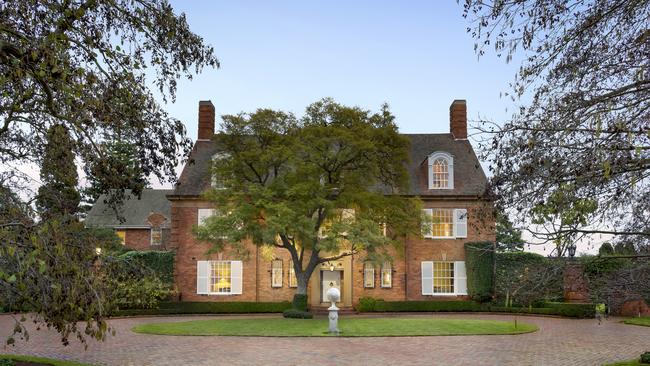
What is it with these newly minted tech billionaires who want to embed themselves amid old money, but recast the landscape in their own, new-money style?
Take prestigious boulevard St Georges Rd in Melbourne’s affluent Toorak, running down from the Yarra up to Toorak Rd and boasting some of the city’s wealthiest residents.
Grant Rule, who founded cloud-based business the SMS tech outfit MessageMedia, is one such rich-lister.
After selling his business in 2021 to Swedish rival Sinch for $US1.3bn, Rule and wife Sophie Oh spent $74.5m in August 2022 to buy the grand mansion Blair House from the Nanut family. At the time, the buy was the second-biggest on record for Melbourne.
The 10-bedder sits in 7800sq m of verdant grounds with a tennis court, but it seems the pad is not quite what Rule, 56, and Oh have in mind for their dream home.

The pair have just submitted plans to spend an estimated $17m at the site, with documents relating to demolition, new construction, and tree and water management being lodged with Stonnington Council for approval.
Seems like it’s out with the old and in with the new, to take their outlay thus far to more than $90m.
Since buying the pile, the couple, who now run their Susan McKinnon Foundation with the objective of enhancing the capability and effectiveness of democratic institutions and government, have maintained their warehouse conversion home in North Fitzroy.
Last month they were back in the real estate market, paying $23.23m for a clifftop home in Portsea that was being sold by Affinity Equity Partners’ Nick Speer and wife Camilla, the daughter of veteran property developer David Deague.
The Rules have also amassed land holdings in Gippsland, all of which are in Oh’s name.
Their path in the city is similar to that unfolding for co-founder of online casino Stake.com Ed Craven, 31, who has recently demolished the so-called ghost mansion, also on St Georges Rd, which he bought for $80m.
Craven is building a $145m modern luxury home on the site, which at the moment is at the stage of being one almighty hole in the ground. Only time will tell if it’s all money well spent.
The mail on closures
Head postie Paul Graham was in Canberra earlier this week to catch up with his political overseers at Senate Estimates – a semi-regular event we are sure the CEO relishes.
Graham, now almost three years into the role, wants more money from banks for providing the Bank@Post service at regional post offices, as more lenders close banks outside cities and Post picks up the slack.
He’s amid talks for more fees, but the 10-year deals with majors were only signed a few years ago, so they are still pretty fresh.
Graham told the Environment and Communications Legislation Committee that bank closures were saving banks “billions”, but pushing costs onto the national carrier, which is subsidising bank profits.

The billions claim itself is dubious – Australia Post vaguely tells us it was a value arrived at after distilling a range of banking royal commission material and banks’ own disclosures – but it’s hard to swallow given Graham’s own intentions to close Australia Post branches, just like the banks have done.
Before the committee, he attempted to conceal the number of post offices earmarked for closure in regional Australia, saying he would only provide that information to the government if it was “commercial in confidence”.
Liberal senator Sarah Henderson – who has been a strong critic of Post after she accused former chief executive Ahmed Fahour of being a “horse’s arse” – asked how many of those post offices would be in rural and regional Australia and asked Graham to provide a list.
“I’m happy to provide that on notice Senator with the commercial in confidence caveat in that these are not publicly known and it could have repercussions with our landlords and other people,” Graham said.
“I understand and accept your concerns about commercial-in-confidence, but that will be a matter for the committee,” Henderson declared.
Graham said Post would maintain its regulatory commitment of operating 2500 post offices in regional Australia. “We have got just over 2572 from memory”.
Closure to save money – sounds like a move straight out the banking sector’s playbook.
Fitch returns
Political folk who were missing the presence of senior Labor staffer Liz Fitch in the halls of Parliament House since her shock exit from the Prime Minister’s Office just before Christmas can look forward to catching up with the spin doctor soon.
Fitch, who had been PM Anthony Albanese’s senior media adviser since the last election, has landed a new role running government affairs for tech giant Microsoft in Australia and New Zealand.
Before working for Albo, Fitch had also worked for now Energy Minister Chris Bowen in opposition in what was her seven-year stint in Canberra.
Her exit followed what was a difficult period for the government, including losing the referendum on the Indigenous voice to parliament and criticism from the opposition over its handling of the High Court decision on immigration detention.
By late January Albo had moved on and hired The Guardian’s political editor Katherine Murphy as a senior member of his media team.
In her new gig, Fitch will report to Microsoft’s local head of corporate, external and legal affairs boss John Galligan, who in his professional past was an adviser to former Liberal senator Bronwyn Bishop and after that a media operative for the Liberal Party. Still, we are sure the new colleagues will get along.
Helpful too will be the goodwill already developed between the Albanese government and the American tech giant via their $5bn deal signed last October to boost Australia’s ability to identify and prevent cyber threats. Cosy, hey.



